Method, user equipment, base station, and system of resource scheduling
A user equipment and resource scheduling technology, applied in electrical components, wireless communication, etc., can solve the problems of waste of resources, high cost, unfavorable terminal wide application, etc., and achieve the effect of cost reduction and high efficiency
- Summary
- Abstract
- Description
- Claims
- Application Information
AI Technical Summary
Problems solved by technology
Method used
Image
Examples
Embodiment 1
[0054] In the LTE system, some user equipments performing detection need to frequently send measurement reports with a small amount of data to the network side, for example, measurement data needs to be reported every 5 minutes, and the rate only needs to be 10 kbit / s. If these user equipments adopt hardware and software that meet the requirements specified in existing protocols, the cost of these user equipments will be very high, and the data transmission rate that these user equipments can achieve will far exceed their actual needs, which not only wastes manufacturing costs, but also It is not conducive to the network side to adopt efficient resource scheduling algorithms for these user equipments, resulting in waste of air interface resources.
[0055] In view of the above problems, this embodiment proposes a new user equipment, which uses a lower rate processing chip, which cannot continuously monitor the signaling on the PDCCH, and can only be separated by one subframe (i...
Embodiment 2
[0074] In the LTE system, some user equipments only need to send and receive small data occasionally, so these user equipments do not need to have strong processing capabilities. In this embodiment, the user equipments do not have the ability to continuously receive PDCCH signaling. The process of accessing the network is as follows: image 3 Shown:
[0075]In step 201, the user equipment initiates random access in the cell where it resides, and sends RRC connection request signaling to the base station to which the cell belongs.
[0076] Step 202, the base station allocates resources for the user equipment, and sends RRC connection establishment signaling to the user equipment.
[0077] Step 203: After receiving the establishment of the RRC connection, the user equipment sends RRC connection establishment completion signaling to the base station, and the signaling also includes non-access stratum signaling sent by the user equipment to the core network, for example, an attac...
Embodiment 3
[0092] Some user equipment in the LTE system are mainly used to receive or send content with a small amount of data. If such user equipment adopts hardware and software that meet the requirements of the existing protocol, the cost of these user equipment will be high, and the air interface resource Waste is also serious. Therefore, the user equipment in this embodiment only has the ability to receive a small amount of data, which is specifically reflected in the limitation of the amount of data that the user equipment can send or receive at one time. For example, the user equipment can only send or receive a maximum of 300 bits of data at a time. For the downlink, the user equipment detects its own PDCCH signaling, and then obtains parameters such as the frequency position, modulation and coding scheme of the PDSCH according to the downlink control information carried in the PDCCH signaling, and detects the PDSCH. If the amount of data that the user equipment can receive at on...
PUM
 Login to View More
Login to View More Abstract
Description
Claims
Application Information
 Login to View More
Login to View More - R&D
- Intellectual Property
- Life Sciences
- Materials
- Tech Scout
- Unparalleled Data Quality
- Higher Quality Content
- 60% Fewer Hallucinations
Browse by: Latest US Patents, China's latest patents, Technical Efficacy Thesaurus, Application Domain, Technology Topic, Popular Technical Reports.
© 2025 PatSnap. All rights reserved.Legal|Privacy policy|Modern Slavery Act Transparency Statement|Sitemap|About US| Contact US: help@patsnap.com



